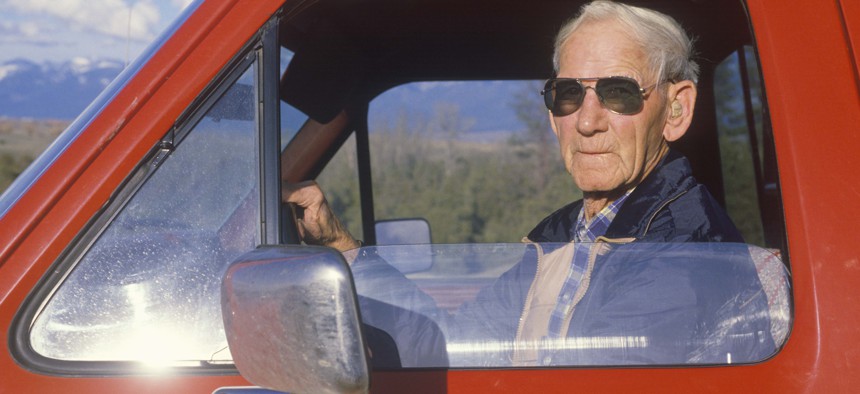It’s Not All About Millennials. Mayors Look to Engage With Seniors.

Shutterstock

Connecting state and local government leaders
“The majority of the people that will show up on Election Day are going to be older voters,” notes an AARP representative.
WASHINGTON — When Mayor Bryan Barnett, of Rochester Hills, Michigan, met earlier this month with local seniors, the county law enforcement officials who came with him brought along some pot.
Michigan voters legalized the drug for recreational use in November and the idea behind the “Mondays With the Mayor” meeting, a regular monthly gathering Barnett holds with older residents in the city, was to familiarize attendees with marijuana and the law change.
“This is what 2.5 ounces look like, this is a brick, this is where you buy it, this is where you can smoke it,” Barnett said Thursday as he rattled off some of the topics they covered.
“Some of the seniors didn’t want to touch it,” he added. “Some of them knew more than our officers did.” The mayor said the event was well attended and people had lots of questions.
(A spokesman for Barnett later confirmed that no marijuana was consumed during the meeting.)
In Gary, Indiana, Mayor Karen Freeman-Wilson described how her city partnered with the Centers for Disease Control and Prevention on outreach efforts and distributed condoms after an increase in sexually transmitted diseases among the city’s senior population.
“Just because somebody’s older doesn’t mean they’re dead,” Freeman-Wilson said.
She and Barnett shared these anecdotes during a discussion about how mayors and city governments can engage with older residents. The conversation took place during an annual meeting of the U.S. Conference of Mayors happening here in D.C. this week.
“If you’re not paying attention to your community seniors, get all you can out of this conference because you won’t be back here next year,” said Barnett, the USCM’s current vice president, cautioning his fellow mayors about the need to pay mind to older constituents.
The overall population in Rochester Hills, which is around 74,000, has grown by about 5 percent over the last decade, he said, while the senior population increased by nearly 15 percent.
Nancy LeaMond, chief advocacy and engagement officer for AARP, shared recent survey results from the group about older voters.
The survey found 78 percent of voters 50 and older show up for every mayoral election. It also shows that 61 percent of these voters hold a favorable view of their mayor, making them one of the most unifying and least divisive elected leaders in the U.S. currently, LeaMond said.
“The majority of the people that will show up on Election Day are going to be older voters,” she told the mayors.
People in this age range, according to LeaMond, tend to be informed and involved when it comes to civic affairs, following local news and still reading newspapers.
Top issues older people are focused on, the survey shows, include jobs and the economy, as well as initiatives that lay groundwork for them to live independently into old age and possibly with disabilities.
They also tend to support investments in transportation and housing, LeaMond said.
But she emphasized that older voters are not monolithic and are spread across multiple generations and include people from a range of racial and ethnic backgrounds, even though they are generally less multicultural than younger generations of American voters.
Boston Mayor Marty Walsh noted that in his city roughly one-quarter of seniors are foreign born.
Walsh pointed out that Boston ranks high when it comes to its share of both older and millennial residents.
“We have a young city coming up and we have an older city,” he said.
LeaMond said in a follow-up email that, over the last two years, AARP has conducted voter engagement efforts for local races, primarily mayoral and city council contests, in 13 municipalities across the U.S. This year the group anticipates being active in as many as 20.
AARP does not endorse candidates or make political contributions.
The group’s participation in elections, LeaMond said, can involve pressing candidates to talk about issues of interest to older voters, and connecting candidates with those voters so they can explain these stances. This may involve “video voter guides,” holding telephone town halls, or cosponsoring debates.
Get out the vote efforts are another area AARP works on, informing people about where they must go to vote and when polls are open.
Freeman-Wilson said one of the things she’s found in her city is that seniors are willing to get involved volunteering. Appointments to boards and commissions were another option she suggested for how older residents could be engaged civically.
“When you think about inclusion, very often people talk about race or gender,” the mayor added. “But increasingly inclusion also means making a city that’s accessible to every generation.”
Correction: An earlier version of this story referred to the American Association of Retired Persons. The organization previously changed its name to just AARP.
Bill Lucia is a Senior Reporter for Route Fifty and is based in Washington, D.C.

NEXT STORY: Clergy Child Abuse Reporting Laws Uneven, Leave Loopholes





